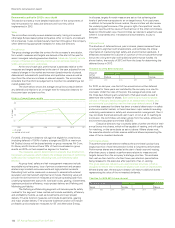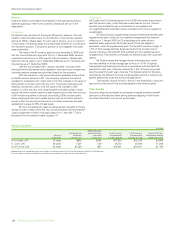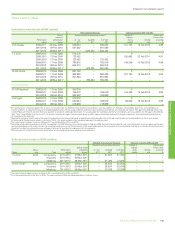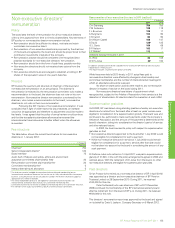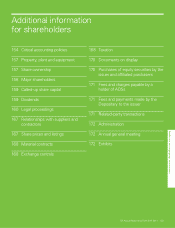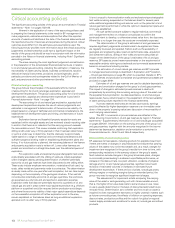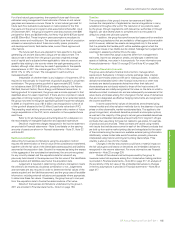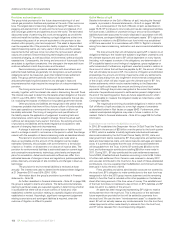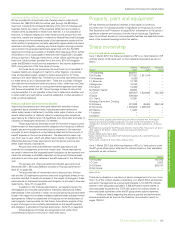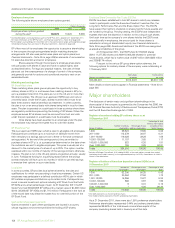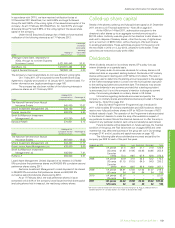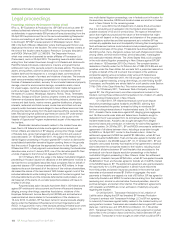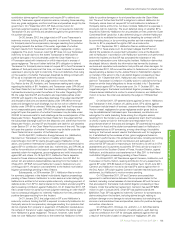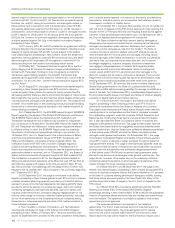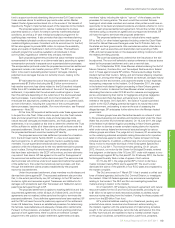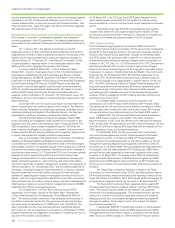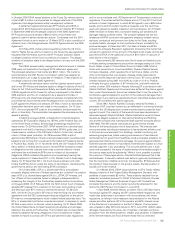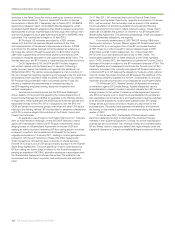BP 2011 Annual Report Download - page 158
Download and view the complete annual report
Please find page 158 of the 2011 BP annual report below. You can navigate through the pages in the report by either clicking on the pages listed below, or by using the keyword search tool below to find specific information within the annual report.
156 BP Annual Report and Form 20-F 2011
Additional information for shareholders
Provisions and contingencies
The group holds provisions for the future decommissioning of oil and
natural gas production facilities and pipelines at the end of their economic
lives. The largest decommissioning obligations facing BP relate to the
plugging and abandonment of wells and the removal and disposal of oil
and natural gas platforms and pipelines around the world. The estimated
discounted costs of performing this work are recognized as we drill the
wells and install the facilities, reflecting our legal obligations at that time.
A corresponding asset of an amount equivalent to the provision is also
created within property, plant and equipment. This asset is depreciated
over the expected life of the production facility or pipeline. Most of these
decommissioning events are many years in the future and the precise
requirements that will have to be met when the removal event actually
occurs are uncertain. Decommissioning technologies and costs are
constantly changing, as well as political, environmental, safety and public
expectations. Consequently, the timing and amounts of future cash flows
are subject to significant uncertainty. Any changes in the expected future
costs are reflected in both the provision and the asset.
Decommissioning provisions associated with downstream and
petrochemicals facilities are generally not recognized, as such potential
obligations cannot be measured, given their indeterminate settlement
dates. The group performs periodic reviews of its downstream
and petrochemicals long-lived assets for any changes in facts and
circumstances that might require the recognition of a decommissioning
provision.
The timing and amount of future expenditures are reviewed
annually, together with the interest rate used in discounting the cash flows.
The interest rate used to determine the balance sheet obligation at the end
of 2011 was 0.5% (2010 1.5%). The interest rate represents the real rate
(i.e. excluding the impacts of inflation) on long-dated government bonds.
Other provisions and liabilities are recognized in the period when
it becomes probable that there will be a future outflow of funds resulting
from past operations or events and the amount of cash outflow can
be reliably estimated. The timing of recognition and quantification of
the liability require the application of judgement to existing facts and
circumstances, which can be subject to change. Since the actual cash
outflows can take place many years in the future, the carrying amounts
of provisions and liabilities are reviewed regularly and adjusted to take
account of changing facts and circumstances.
A change in estimate of a recognized provision or liability would
result in a charge or credit to net income in the period in which the change
occurs (with the exception of decommissioning costs as described above).
Provisions for environmental remediation are made when a
clean-up is probable and the amount of the obligation can be reliably
estimated. Generally, this coincides with commitment to a formal plan
of action or, if earlier, on divestment or on closure of inactive sites. The
provision for environmental liabilities is estimated based on current legal
and constructive requirements, technology, price levels and expected
plans for remediation. Actual costs and cash outflows can differ from
estimates because of changes in laws and regulations, public expectations,
prices, discovery and analysis of site conditions and changes in clean-up
technology.
The provision for environmental liabilities is reviewed at least
annually. The interest rate used to determine the balance sheet obligation
at 31 December 2011 was 0.5% (2010 1.5%).
Information about the group’s provisions is provided in Financial
statements – Note 36.
As further described in Financial statements – Note 43 on page 249,
the group is subject to claims and actions. The facts and circumstances
relating to particular cases are evaluated regularly in determining whether
it is probable that there will be a future outflow of funds and, once
established, whether a provision relating to a specific litigation should be
established or revised. Accordingly, significant management judgement
relating to provisions and contingent liabilities is required, since the
outcome of litigation is difficult to predict.
Gulf of Mexico oil spill
Detailed information on the Gulf of Mexico oil spill, including the financial
impacts, is provided in Financial statements – Note 2 on pages 190-194.
As a consequence of the Gulf of Mexico oil spill, as described on
pages 76-79, BP continues to incur costs and has also recognized liabilities
for future costs. Liabilities of uncertain timing or amount and contingent
liabilities have been accounted for and/or disclosed in accordance with IAS
37 ‘Provisions, contingent liabilities and contingent assets’. BP’s rights and
obligations in relation to the $20-billion trust fund which was established
in 2010 are accounted for in accordance with IFRIC 5 ‘Rights to interests
arising from decommissioning, restoration and environmental rehabilitation
funds’.
The total amounts that will ultimately be paid by BP in relation to all
obligations relating to the incident are subject to significant uncertainty and
the ultimate exposure and cost to BP will be dependent on many factors
(including, with respect to certain of the obligations, any determination of
BP’s culpability based on any findings of negligence, gross negligence or
wilful misconduct). Furthermore, significant uncertainty exists in relation to
the amount of claims that will become payable by BP, the amount of fines
that will ultimately be levied on BP, the outcome of litigation and arbitration
proceedings, the amount and timing of payments under any settlements,
and any costs arising from any longer-term environmental consequences
of the oil spill, which will also impact upon the ultimate cost for BP. Any
further settlements which may be reached relating to the Deepwater
Horizon oil spill could impact the amount and timing of any future
payments. Although the provision recognized is the current best reliable
estimate of expenditures required to settle certain present obligations at
the end of the reporting period, there are future expenditures for which
it is not possible to measure the obligation reliably as noted below under
Contingent liabilities.
The magnitude and timing of possible obligations in relation to the
Gulf of Mexico oil spill are subject to a very high degree of uncertainty
as described further in Risk factors on pages 59-63. Furthermore, other
material unanticipated obligations may arise in future in relation to the
incident. Refer to Financial statements – Note 43 on page 249 for further
information.
Expenditure to be met from the $20-billion trust fund
In 2010, BP established the Deepwater Horizon Oil Spill Trust (the Trust) to
be funded in the amount of $20 billion over the period to the fourth quarter
of 2013, which is available to satisfy legitimate individual and business
claims administered by the Gulf Coast Claims Facility (GCCF), state and
local government claims resolved by BP, final judgments and settlements,
state and local response costs, and natural resource damages and related
costs. It is currently expected that the cost of the proposed settlement
will be payable from the Trust. In 2010, BP contributed $5 billion to the
fund, and further regular contributions totalling $5 billion were made in
2011. During 2011, BP also contributed the cash settlements received
from MOEX, Weatherford and Anadarko amounting in total to $5.1 billion.
A further cash settlement from Cameron was received in January 2012
and was also contributed to the trust fund. As a result of these accelerated
contributions, it is now expected that the $20-billion commitment will have
been paid in full by the end of 2012.
Fines, penalties and claims administration costs are not covered by
the trust fund. BP’s obligation to make contributions to the trust fund was
recognized in full in the 2010 group income statement and the remaining
liability to fund the Trust is included within other payables on the balance
sheet after taking account of the time value of money. The establishment
of the trust fund does not represent a cap or floor on BP’s liabilities and BP
does not admit to a liability of this amount.
An asset has been recognized representing BP’s right to receive
reimbursement from the trust fund. This is the portion of the estimated
future expenditure provided for that will be settled by payments from
the trust fund. We use the term “reimbursement asset” to describe this
asset. BP will not actually receive any reimbursements from the trust fund,
instead payments will be made directly to claimants from the trust fund,
and BP will be released from its corresponding obligation.


